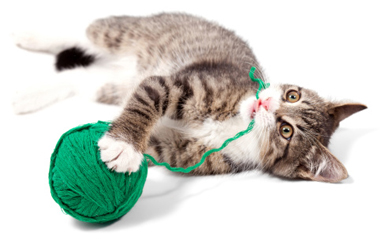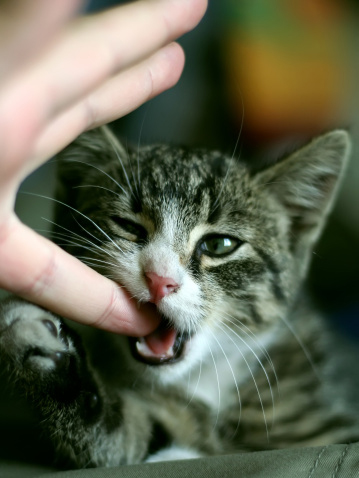The first thing you should keep in mind when kitten training is to remember there is no such thing as a bad kitty!
When the little guy scales your drapery, he is not doing it to make you mad!
The key to kitten training is to redirect this natural behavior so that kittens and humans can coexist in peace in the same household.
The following tips will help you to make the process less of a struggle, and become more of a loving bonding experience.
Kitten Training Tip #1: Work With Your Kitten, Not Against Him
Natural cat and kitten behaviors such as clawing and scratching is not something you can train away.
To protect your furniture, you cannot continue to scold or shoo him, you need to provide an alternative. A scratching post or two near the tempting sofa is a good bet.
When your kitten approaches your couch, don’t yell or frighten him, just pick him up and place him on the scratching post.
You have to be diligent and do this repeatedly in the beginning. Cat and kitten training takes work and consistency is key!
Same goes for if he enjoys climbing the drapery (and you have to admit, it does look pretty fun!) Either convert to blinds, or think about getting him a kitty play gym for him to climb to his little heart’s content.
If you are considering declawing your kitten, please do your research–there can be complications and risks involved, and it’s not a decision to be taken lightly.
Make sure he has other toys to play with. We favor catnip-filled soft toys to keep cats occupied.
For litter box training very young kittens, the same method of gentle persuasion is the best way to make kitten training a positive experience.
About Litter Box Training…
Problems with kittens using the litter tray is a whole other topic in itself.
If you have a kitten that won’t learn how to eliminate appropriately or an adult cat that suddenly stopped using his litter box, you can get some help right away by reading my mini report The Litter Box Training Action Guide. Find out how to get the guide here.
Kitten Training Tip #2: Know Your Species!
Kittens are not puppies.

OK, you probably knew that. Basically, your approach will need to be completely different if you want to achieve a positive outcome.
You will have noticed your kitten doesn’t enjoy wrestling with you or playing tug-of-war. He also doesn’t do anything that he doesn’t see value in.
As pack animals, dogs and puppies want to make you happy so they can continue to enjoy their status as members of your pack. Cats are primarily solitary animals, and they have a “what’s in it for me?” attitude.
Kitten training involves a bit more subtlety and more of a “payout.” Food treats (not pieces of his regular kitten food) work as a great motivator for most kittens, but some prefer cuddles or playtime.
Know his motivator!
All creatures learn faster with positive reinforcement rather than negative.
Dogs and puppies will still do what you want even if trained negatively (not recommended) because being part of the pack is all-important.
The feline species, however, will not respond well to negative kitten training.
Kitten Training Tip #3: Never Punish Your Kitten
Never, ever hit your kitten. He will not associate your action with a “bad” deed and he will just learn to fear you and your hand.
If he likes jumping on the counter or making a too-close inspection of your milk-laden empty cereal bowl, say a firm “NO” and clap your hands so he gets the message.
Other effective kitten training methods include shooting a water gun at him from a distance (just don’t aim for his face, eyes or ears) or fill a soda can with pennies, and toss it in the air to land next to him.
The startling and unpleasant consequence will be remembered in the future.
As stated earlier though, it can take many times before the training sinks in. This is due to stubbornness, not a lack of intelligence.
In fact, cat intelligence is greatly underrated, since many owners will tell you that their cat trained them! Don’t let him get away with it…
Training Tip #4: Don’t Give In!
Cat and kitten owners have some of the craziest stories: “I have to get my cat a snack every morning at 3:00am,” or “My cat will lick my nose while I’m in bed until I get up to let him out” or “My cat bites my hand when I stop petting him!”
Funny stories yes, but living with such, shall I say “spoiled” behavior should not be tolerated.
These are examples of cats and kittens training their owners; They experiment with a behavior, and the behavior is rewarded with the desired consequence.
If you don’t want to get up at 3:00 in the morning to feed your cat everyday, then don’t do it…ever!
If the pattern has already been set, it will take a bit of time and some sleeplessness as she continues to meow every morning, but just ignore her for as long as it takes.
If you are feeding her properly then you know her peskiness is not a hunger issue, but just a way to get what she wants from you.
Think you’re innocent? When your cat meows at you, do you talk to her or reach down to pet her? Of course you do! We are not suggesting you stop paying attention to your cat!
We are simply pointing out that cats are great manipulators so be careful what you let them get away with!
If you have a brand new kitten, you’re lucky! You can learn from these mistakes and begin kitten training early. It is much easier to do it right at the beginning than to break bad habits.
Training Tip #5: Teaching Tricks and Other Behaviors
Kitten training can be a great way to begin a bonding experience together.
While positive re-direction needs to be done on-the-spot, setting aside quiet time every day to train your kitten to learn specific behaviors or tricks is good for his mental and psychological growth.
Set the kitten training and bonding time for when you are both relaxed and in the mood. Waiting until the very end of the day when you are tired will likely lead to frustration and impatience on your part.
This is not fair to the kitten.
Also read his cues; If he seems too agitated or distracted, save the training session for another time.
It is best to do your kitten training in a room without other people or pets to distract him. Begin slowly with small chunks of time, no more than 15 or 20 minutes.
Always be gentle, and have plenty of tasty treats (or other motivators) on hand.
A good first session for training kittens is to teach him to respond to his name.
Talk to him gently while petting him. Don’t begin a play session, he will just be in eager-young-predator mode and start biting you (called play aggression.)
Keep these training interactions quiet and focused. Say his name often in a tone to get his attention. When he looks up at you after saying his name, give him praise and a treat or cuddle time.
Try Clicker Training Your Kitten
You can even get a cat clicker to help with the kitten training process. The idea is to click at the precise moment of desired behavior.
Some kittens don’t like the sound of the clicker, so don’t use it if your kitten doesn’t respond well, but animal trainers believe this helps “cement” the training more quickly, since your kitten will know exactly what behavior got him the click.
Whether you train kittens with a clicker or not, knowing how to use only positive reinforcement when kitten training will help you train your kitten to do lots of things!
You can teach him to come when called, get used to a kitten harness, and learn cute kitten tricks!
Just remember: Love, patience, and kindness are your best tools for training kittens.







